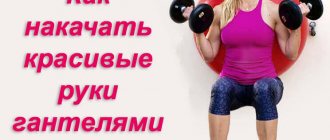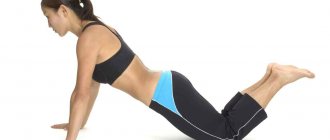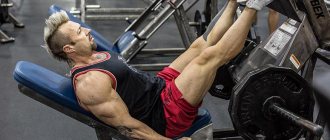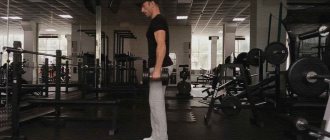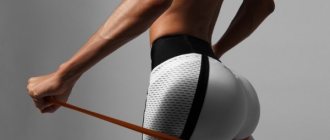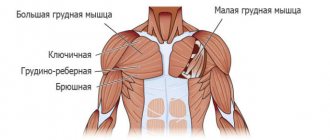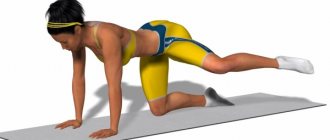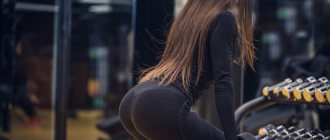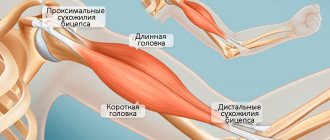If you think about it for a second, generally speaking, unless you live on the beach (or walk around town in a tank top), you don't get the opportunity to show off your muscles very often.
Of course, a well-defined shape still makes itself felt, especially if you wear well-tailored clothes, but when it comes to exposed skin, it's almost exclusively the arms. That's why big, muscular arms get so much attention.
And luckily, increasing your arm strength and size isn't actually that hard.
By working your arms and using this set of arm exercises, you will literally feel how your muscles quickly become stronger and increase in size.
All you need to do (besides the classes themselves) is keep reading!
The most important thing about your hands
Before we move on to the first exercises, let's go over the basics.
The main components of the arm muscles are the forearms, biceps and triceps. Depending on the training program, shoulders are also distinguished, but it is usually better to include them in back and chest workouts (since many heavy movements involve the shoulder muscles).
In other words, we will mainly train the biceps and triceps.
So, for optimal hand training, there are two main methods. If you want to increase size, perform two or three sets of 8-12 reps. If you want to get stronger, do 4-5 reps. For some exercises, strength increases with 1-4 reps, but a one-rep set of biceps curls won't do much for you.
You will also need to consume a lot of protein. No matter what type of training you do in the gym, if you're not getting enough protein to repair muscle tissue, it will be much more difficult to gain size.
Your arm muscles also use protein for energy, so you don't have to think about it in terms of calories. As long as you eat lean protein and stay on a low-calorie diet (this means no fried foods or certain high-calorie ingredients), you can eat as much as you want. When it comes to increasing muscle size, protein recommendations vary from expert to expert. Aim for 2-2.5 grams of protein per kilogram of body weight for maximum muscle gain.
A set of exercises for pumping up your arms
When creating your own complex, be it exercises to tighten your arms, or to develop strength and volume, you must keep in mind that it should be based on basic exercises - you can’t pump up your arms only by isolated ones. For a man wondering how to pump up his arms in the gym, it is important not to get hung up on one complex. And every 1.5 months. change it, and do not forget to rearrange the exercises within the complex. The correct answer to how to pump up your arms in the gym also lies in a conscientious attitude towards training, in the ability to train with dedication, “not to shirk.”
Warm-up
Start warming up before training your biceps and triceps with vigorous exercises for your hands: before each strength training session in the gym, you should definitely warm up. Including if your goal is simply toned arms, and you have to do exercises to tighten your arms with light weights.
As you rise higher, stretch your elbows and then your shoulder joints (required!). These joints are real risk areas, more susceptible to injuries and sprains than other places in the body.
For newbies
Beginners need to train their arms 1-2 times a week (the question of whether it is possible to train biceps daily can be answered in the affirmative; it’s just that the benefits of frequent training are questionable). The complex should be composed of basic exercises for arm mass; and isolated exercises for working out the relief in the gym for men are better left for later. Compound exercises recruit more muscle fibers and place more stress on the muscles, stimulating them to grow.
After doing the first approach with a small warm-up weight, and making sure that you can stick to the correct technique, repeat the exercise for another 2-3 approaches with the working weight. The number of exercises should initially be 2 for each muscle group; then - 3, and no more. The main thing in these exercises is strict adherence to technique, controlled movements with constant muscle tension.
After completing the third approach, the exercise should be completed and, after a minute's rest, begin the exercise on the antagonist muscle. In total, the arm workout should last about 40 minutes.
A sample training plan for a beginner should look like this:
- Standing biceps curls with W-shaped bar: 3x10-12;
- French press with W-shaped bar from behind the head: 3x10-12;
- Biceps curls on a Scott bench: 3x10-12;
- Reverse push-ups from the bench: 3x8-10.
For advanced
Experienced athletes already know from their own experience how many times a week they need to pump their biceps, and they approach this without excessive fanaticism. For those who have already built up a certain muscle mass and are working on relief, it makes sense to perform exercises for the inner part of the arms for 12-15 repetitions without losing intensity. Some people also begin to additionally pump up their forearms - separately, using isolated exercises for these muscles, sometimes included in complexes for women. When performing arm strength exercises, you should remember the importance of the last 2 repetitions. That is, after you have already mentally said to yourself “enough,” you need to do it 2 more times, which is where the main benefit lies.
In training for advanced people, exercises with dumbbells for the biceps and triceps are more widely used - for detailed study of the internal bundles of the biceps and triceps and polishing their relief. The following rules are also relevant: watch your breathing: it should be uniform, with an effortful exhalation; slowly lift the weight and lower it even more slowly, with brief fixation at the extreme points; When pumping arm muscles while standing, bend your knees slightly - for stability and to prevent cheating. Be sure to use supersets.
A sample training plan for advanced ones would look like this:
- Reverse grip pull-ups: 2x8-10.
- Standing biceps curls with dumbbells: 4x12-15;
- Concentrated raises on a Scott bench: 4x12-15;
- French press with a dumbbell standing behind the head: 4x12-15;
- Triceps extensions in a crossover with a rope: 4x15-20;
- “Hammer” with gateel: 4x12-15;
- Reverse push-ups from the bench: 4x12-15.
For girls
Sets of arm exercises for women have a different purpose. This is not about increasing muscle size. The goal is relief, fit and overall tone. Therefore, girls need to select a set of exercises for arms in the gym in such a way as to avoid exercises on mass.
The best exercises for strengthening women are exercises with dumbbells for the biceps, triceps and forearm muscles. When using dumbbells, in addition to the target muscles, stabilizer muscles also come into play. Part of the load is removed from the main muscle, but the arms are worked out comprehensively and harmoniously. In this way, you can give your muscles a consistently vigorous tone and get rid of both overly round and overly thin limbs.
A sample plan for girls would look like this:
- Standing biceps curls with dumbbells: 4x12-15;
- Triceps crossover extensions with a rope: 4x12-15;
- Biceps crossover curls with V-shaped handle: 4x12-15;
- Reverse push-ups from the bench: 4x8-10.
BONUS for advanced athletes! Arm workout from the Fit Magazine team!
We decided not only to share the theory with you in this article, but also to show that we are practitioners. Especially for you, we filmed a cool arm workout with Maxim Pechenkin. We advise you to take a look at this complex, as you will get acquainted with many exercises and tricks that you have not tried yet!
Stretching
By distributing the load, arm training can and should end with a small set of stretching exercises. It makes sense to start not only this, but most workouts with warm-up exercises and end with stretching. Then each movement of the main exercises will be performed with greater amplitude and more under control. Particular attention should be paid to stretching the muscle groups of the shoulder girdle.
The hand stretch can be seen in the picture below:
At home
Many believe that the main problem with training at home, including when performing biceps, triceps and forearm exercises for women, is the lack of equipment. In fact, the only problem with organizing homework is a lack of self-discipline.
Even the absence of dumbbells can be perfectly replaced with bottles of water or sand, performing the same exercises for the arms with them. It should be remembered when training arm strength that this indicator can generally be developed only using your own weight, without resorting to training in the gym. All types of push-ups and parallel bars will help; pull-ups on the bar.
You can also train your arms at home without weights. It is enough to do:
- Push-ups with narrow arms (for triceps development);
- Reverse push-ups (for triceps development);
- Reverse grip pull-ups (for biceps development).
Myths regarding arm training
There are many misconceptions about arm training.
When you see someone with arms as big as tree trunks, you might think that they probably train their biceps and triceps every day. However, this is not at all true. In fact, it often happens that in order to grow muscles, you don’t need to train your arms separately at all.
Since evolution put us on the lower limbs, the muscles of the upper body have been much less necessary. That is why the largest muscles of the body are the legs. Over the past eras, the hands have become involved in a much smaller volume compared to other areas of the body. This means that the upper muscles are subject to less stress on a daily basis.
Because these muscles do less hard work, they take a long time to recover. Do a set of arm exercises once, maximum twice a week. By doing more, you reduce valuable rest time and thereby reduce the amount of work you could put into training your chest and back.
Another misconception is that big arms require heavy weights. Yes, heavier weights can help increase size.
However, there is only so much you can move or lift with your arms. There are plenty of people with incredibly sculpted arms who use nothing but their own body weight to train.
So don't worry: even if you work out at home and don't have a ton of money to buy equipment (and luckily your hands don't need that), there is still always a way out.
Anatomy of arm muscles
The arms have rather short and less massive muscles compared to the lower part of the body, so exercises for the arm muscles do not require a large number of approaches. The main muscles of the arm are the biceps, its flexor, and the triceps, its extensor. They do the opposite job and are called antagonists. Associated with them, performing a supporting function during all movements, are the muscles of the forearm: brachialis, brachyradialis, flexor carpi radialis longus and coracoid muscle.
For a modern city dweller, all these muscles are not much involved in everyday life and do not receive serious loads. Therefore, for those who do not regularly engage in sports or heavy physical labor, they retain a soft and pliable structure even under stress.
The biceps is a thick biceps muscle, both heads of which are attached to the upper arm at the top, to the forearm bone at the bottom, and unite in the middle. The triceps, a more massive triceps muscle than the biceps, also has two heads that begin on the shoulder, and the third on the shoulder blade. And they merge on the process of the ulna. The muscles of the forearm create supporting platforms for the biceps and triceps and, as it were, “push” them out when working.
In sports practice, when compiling a set of exercises for the arms, it is necessary to take into account such anatomical features. The development of the inner part of the biceps gives it height, and the outer part gives it width. The outer head is worked through exercises with a large amplitude and bending the arm to the shoulder. Internal - isolated exercises with a small amplitude and bends slightly across the body (as if the right arm is trying to bend towards the left shoulder).
In order to harmoniously develop the triceps, you also need to influence its three heads evenly and anatomically correctly. When working the middle head, you need to make sure that your elbows do not move apart when doing the exercises. The long head is activated when the hand with the load is placed behind the head. Medium – when the arms are along the body during the exercise, the elbows are close to the sides.
Never overwork yourself
We've already touched on this aspect, but arm fatigue is a very important issue, so let's delve a little deeper into it.
There is nothing easier than retraining your hands. Too many people want giant biceps, so they do multiple sets of dumbbell curls even if they're having leg day.
This is a big mistake!
From a global perspective, this has a negative impact on weight gain. Since the arm muscles are not designed for long-term intense loads, they have a long recovery time. If you constantly stress your biceps and triceps during training, you will disrupt the healing process.
So, if your arms are constantly working overtime and you still don't see any progress, it's most likely due to overwork.
Top to bottom, left:
Triceps, anconeus, extensor carpi ulnaris, extensor carpi radialis longus
Top to bottom, right:
Deltoid muscle, biceps muscle, brachialis muscle, brachioradialis muscle.
Heads of biceps and triceps
The best way to strengthen your arms is to understand how the heads of the muscles work.
This way you will understand what you are missing and what basic arm exercises you need to do to train your muscles. Your biceps consists of two heads. Namely - from external and internal. The inner head is responsible for the height of the biceps, the outer head for the width.
The triceps have three heads. The lateral one runs along the entire length of the back of the shoulder. The long head of the triceps curls up and meets the shoulder. The third head is called the middle one. It wraps towards the biceps and is located directly under the long one.
All three of these heads together form the horseshoe shape that can be seen on the triceps.
Working out the heads
Typically, your grip and position will influence which head you work.
Let's start with the biceps.
If you hold the bar close to your body or even move it across your body (imagine bending your right arm toward the left side of your body), you are working the inner head. If you want to engage the outside head, the grip needs to be a little looser (instead of holding the bar directly to your body, make a longer bend, as if you were trying to reach your shoulder).
To do the most effective exercises for the lateral head of the triceps, you need to keep your arms close to your sides. Examples of such exercises are push-ups or French presses. The long head is used when the arm is placed behind the head (such as a bodyweight French press, which we'll get to later).
The middle head is used when placing the arms along the body and with a reverse grip.
Training SCHEMES (programs): go for it!
If only hands are targeted, then the scheme could be like this:
- Standing barbell curls or even better, reverse grip biceps pull-ups 4x6-12
- Close grip bench press 4x6-12
- Hammer Curls" (HAMMERS with standing dumbbells) 4x6-12
- Dips (emphasis on triceps) 4x6-12
I consider this the MAXIMUM EFFECTIVE COMPLEX FOR THE RAPID GROWTH OF ARM MUSCLE MASS. In my opinion, the vast majority of people don’t need more!
For advanced, I emphasize ADVANCED athletes, the scheme may be as follows:
- Reverse grip biceps pull-ups 4x6-12
- Bars (triceps emphasis) 4x6-12
- Barbell curl for biceps 4x6-12
- Close grip barbell press 4x6-12
- Hammer Curls" (HAMMERS with standing dumbbells) 4x6-12
- French bench press 4x6-12
The best exercises for arms!
For biceps
The great thing about arm exercises is that good biceps movements also work the triceps (and good triceps movements also work the biceps).
The key here is to return to the starting position slowly and in a controlled manner. If you're doing a standard curl, don't just throw weights. Count to at least two as you move down. If you only have access to light weights (or resistance bands), increase the count to four.
This simply increases the time under tension and the work done by the muscle, which increases the incidence of microtrauma and aids in volume growth.
Biceps curl while lying on an incline bench
The best arm exercises are movements that stretch the muscles more.
A longer stretch puts more tension on the muscle, which results in more microtrauma and ultimately larger, stronger muscles. That's why the incline curl tops this list. Few isolated arm strength exercises provide as much of a stretch as this one.
Plus, this is a great move for the triceps too.
In order to perform it, you will need an incline bench. Hold a dumbbell in each hand and let your arms hang naturally at your sides. Slowly bend your arm with the weight, hold it at the top point, then slowly lower it. This movement is great for targeting the triceps, so be sure to keep the movement fluid. From the starting position, stretch your biceps even further, tense your arm and move it even further back.
This will create additional tension on the triceps.
Squeeze your triceps and lift your arm up for the next rep.
Squeezing your triceps at the end of the movement isn't necessary, as it's just an added movement built into the regular incline curl, but it will pay off if you do it.
Scott Bench Curls
You already know what a regular bicep curl looks like.
Plus, bending on an inclined surface stretches the arms more, which causes more microtrauma. Instead of focusing on the regular fold, we'll look at the Scott Bench fold. The benefit of this is that you can vary the movement to target the inner or outer head of the muscle. Few exercises for the arm muscles provide such an opportunity for direct impact. For the same reason, it is better to use dumbbells for curls on the Scott bench.
Sit behind Scott's bench.
If you don't have access to one, you can simply use an incline bench: stand behind it and use the incline as an elbow rest. By focusing on each arm separately, you can perform a much more closed curl (or cross-body curl) to engage the inner head. If you want, you can do one approach on the inside, the second on the outside.
And that's the beauty of the Scott Bench fold.
The best triceps exercises
French press
As we said earlier, we’ll get to this exercise for the arm muscles, and now we’ve finally got there.
For this arm-building exercise, grab a short barbell (or dumbbells if you prefer, but this will require extra effort to balance, so if you have weak shoulders, it's best to start with a barbell). Lie down on a bench and hold a loaded barbell overhead. It is better that the elbows are slightly bent, the grip should be narrow.
Lower your hands until they are near your hairline. This way all the tension will be concentrated in the triceps. Slowly lift the barbell to the starting position (this engages the biceps) and hold it with slightly bent arms. Thanks to this, you will engage your biceps and better work your arm muscles.
Dips
You don't need weights to work your triceps; there are other arm exercises in the gym.
Remember earlier when we said that one of the biggest misconceptions is that you need heavy weights to get big strong arms?
Dips prove that this is not true (of course, you can challenge yourself and use leg weights or a weighted vest). It is best to do push-ups so that you are completely off the ground. Make sure your body remains perfectly straight as you move down, with your elbows bent at a 90-degree angle, pause to stretch the muscles as much as possible, and return to the starting position. If you're doing the exercise at home and don't have access to full parallel bars, use a coffee table while extending your legs.
This way you're not putting your full body weight on your arms, but it's still a great exercise.
Triceps extensions in the block
This is an arm exercise in the gym. For this exercise you will need a cable machine. Stand with your back to the machine and grab the cable overhead using a straight bar. It should be at about chest level, so your arms are bent at a 90-degree angle. Pull the cable. Since your elbows are pressed to your body, you will be working primarily on the lateral and medial heads. Lower the weight slowly to target the inner head of the biceps.
Triceps
The triceps are designed to extend the arm and are located on both sides of the shoulder: along the back and the outer part of the arm. When the arms are bent, the triceps form "horseshoes" at the back of the shoulders. Many athletes, when choosing exercises for the arm muscles, take effective exercises for the biceps, but almost ignore the triceps. For the reason that this muscle “is also involved in exercises for other muscles,” or “it is not as effective and important as the biceps.” This is not true: without a well-developed triceps, there will be no spectacular “bank” of biceps.
Close grip bench press
Any strength exercise for the arms should not be complete without this version of the press. It perfectly tightens the back surface of the arms, removing the notorious “jelly” from there (which makes it a valuable exercise for women too).
The grip should be such that the distance between the hands does not exceed 30 cm. When lowering the barbell, the triceps should “slide” along the body. The lowest point is a light touch of the hands with the chest bar. Here you need to tense your triceps and chest, and after a second, energetically “push” the load up. At the top point, pause too.
Dips
Another useful exercise for the back of the arms, suitable for women. Starting position: arms straightened, legs and torso strictly perpendicular to the floor. When performing dips, lower yourself until your arms and shoulders are parallel to the floor, but not lower. Without jerking, but energetically return to the starting position.
French press
If there is an exercise that is ideal for working certain muscle groups in the arms, it is the French press. Moreover, it is not so important in what position it is performed: standing, sitting or lying down: the triceps are always fully involved.
You need to take the barbell with an overhand grip, placing your hands narrower than your shoulders. Do not overdo the weight: otherwise the exercise will not only be beneficial for the triceps, but also harmful to the elbow joints. The main thing in the technique is that the elbows remain motionless when bending/extending the arms, without moving to the sides or “sliding” back and forth.
Extension of arms on a block
Among the most effective physical exercises for developing arm strength and volume, arm extension on a block also takes pride of place. This exercise is for use specifically in the gym. It makes sense to perform it with a cable in one workout, and with a “stick” in another. It is important to maintain a constant body position when moving, and your elbows should be close to your sides.
Arm extension with dumbbell standing/sitting
When asked how to properly perform arm exercises, many people make a mistake in this exercise. This exercise is not basic, for the lower arms. It is better to do it towards the end of the training, to “finish off” the triceps. A common mistake is “floating” elbows. It is necessary to ensure that they maintain a constant position during extension.
Extension of arms with a dumbbell from behind the head
An isolated exercise for “warming up” at the beginning of a workout, or for “finishing off” the triceps at the end of it. When pumping up your arms and wondering how often you need to pump up your biceps, you must not forget that the triceps should also be thoroughly worked out in each such workout. When extending your arms, place them with your palms facing up. Your shoulders should be kept motionless and your back straight. Starting position – the right hand with a dumbbell is raised above the head. Keeping your shoulders still and your elbows as close to your head as possible, begin to bend your right arm. Having fixed for a second at the bottom point, extend your arm to the top point, where you also take a short pause.
Reverse push-ups
Bench extensions are a simpler version of dips. But no less effective. The body should be a smooth and flat “bridge”. When the arms are bent at the elbow joints, the arms and shoulders should eventually assume a position parallel to the floor. In this position it is important for 1-2 seconds. fixate, feeling the tension in the triceps.
